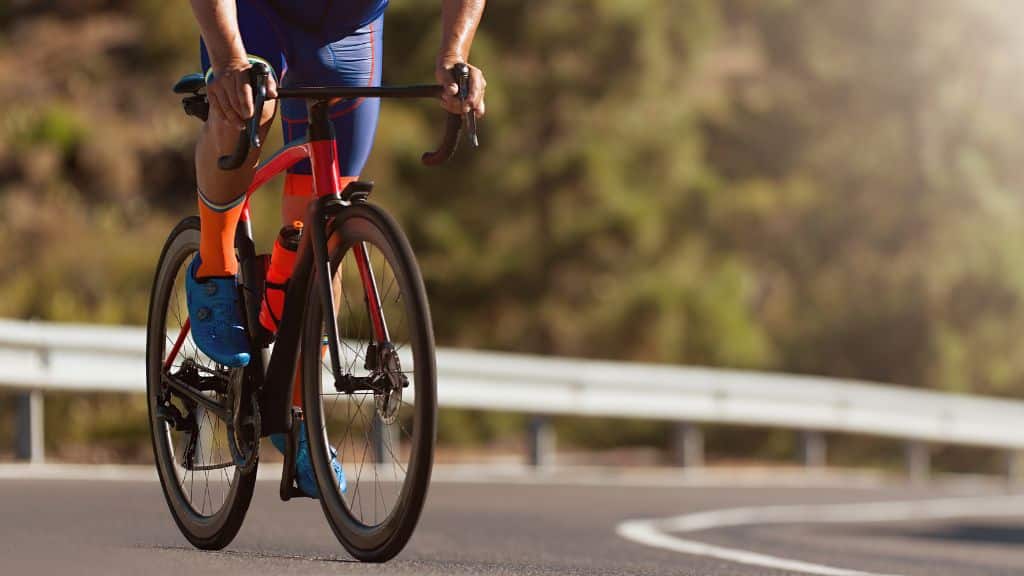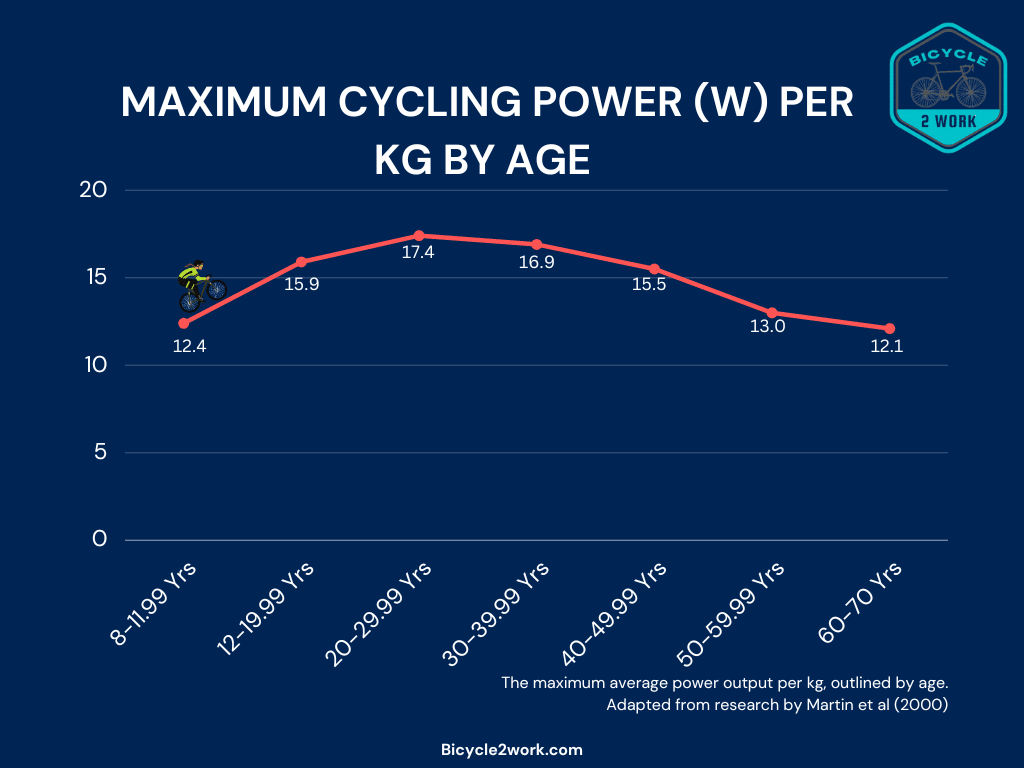This post may contain affiliate links. If you click an affiliate link and make a purchase, I may earn a commission. Also, as an Amazon Associate, I earn from qualifying purchases.--
So according to your power meter, you achieved X amount of watts for your ride. But what wattage number is deemed average? How does yours compare to a beginner or pro cyclist? You’ll want to know this not only as a means for comparison but to set an attainable goal to increase your power and fitness.
But hold up. Simply comparing your wattage number against other cyclists’ is not a suitable way to determine how fit or powerful you actually are. It depends not only on your watts produced but how much you produce given your weight and how long your route is.
For a beginner cyclist, the average maximum watts is 2.11 per kilogram over 5 minutes. An amateur cyclist is likely to have a ratio of 3.5 Watts/Kg over 5 minutes. This gradually increases the more experienced a cyclist is.
Curious why it’s important to measure it per kilogram? In this article, we’ll dive into that and find out what is considered average for a beginner, amateur, and pro cyclist. We will also consider all the factors that can impact your power output, so you can get a good idea of your fitness level and set appropriate goals.

Why Power-To-Weight Ratio (Watts/KG) Is A Better Measurement
Let’s imagine a scenario where both you and your cycling buddy achieve a power of 180 watts over a 20-minute ride. Your buddy weighs more than you. Did you both use the same amount of energy to achieve that?
The answer is no. That’s because the more a person weighs, the more energy they need to exert to propel their weight forward on the same route. Lighter riders require less power to overcome inertia and move forward (source). Accordingly, a measurement of power output which factors in one’s weight is a fairer and better indicator of one’s ability compared to other cyclists (beginner, amateur, and pro) than power alone.
The power-to-weight ratio measures the amount of power you produce on your bike, compared to your weight. In other words, it measures how efficiently your body utilizes its mass to produce power.
It is measured as your power in watts (W) divided by your weight in kilograms (Kg). Since changes in fitness often occur in line with changes in weight, the power-to-weight ratio is a great way to understand and track how your cycling ability evolves.
In addition to weight, how long a cyclist rides can skew how much energy is exerted. Therefore factoring these into the measurement of power is valuable. Let’s consider this in the next section before we look at average power output against other cyclists (beginner, amateur, and pro) later in this article.
Use Functional Threshold Power (FTP) To Work Out Power-To-Weight Ratio
In order to measure your power-to-weight ratio, you need to know your functional threshold power (FTP). Don’t be put off by how big the term sounds. It’s basically the average number of watts you can sustain over a given period of time (i.e. 5 minutes, 20 minutes, 1 hour) (source).
It also refers to a steady (or ramp-up) effort and not the irregular, varied set of results you can expect from a hilly route or a HIIT workout.
All you need is your smart trainer or an indoor cycling app to measure your FTP. There are various ways to do so. Here are three ways summarised in a table: an 8-minute and 20-minute traditional FTP test and a ramp test.
| Test Type | Effort Type Needed | Time Duration | FTP Calculation |
|---|---|---|---|
| Traditional 20-min FTP Test | Steady pace from start to finish | 1 hour including 30-min warmup and 10-min cooldown (source) | 95% of your average power |
| Traditional 8-min FTP Test | Steady pace from start to finish | 40 min including two 8-min intervals with 10-min rest in between, warmup, and cooldown. | 90% of your average total power over the two tests |
| Ramp Test | Ramped (progressively harder until target power cannot be maintained.). | 25 mins including warmup and cooldown (source) | 75% of your best 1-min power during the test. |
We prefer to use the ramp test because it doesn’t require pacing, doesn’t take as much time, is more efficient, is easier to repeat, and hurts less than a traditional FTP test (source).
Here is a useful, short video explaining how to do the ramp test:
After you find out your FTP, all you will need is your weight currently (in Kg) to figure out your power-to-weight ratio. For example, if your FTP is 190 watts, and you weigh 82 Kg, then your power-to-weight ratio is 2.32. That means you’re able to produce 2.32 watts of power for each kilogram you weigh.
Average Watts Per Kg For Cyclists
But how does your W/kg compare with other cyclists?
Now that we’ve outlined the importance of weight as a function of power output, and how to measure your FTP and power-to-weight ratio, let’s find out how yours stacks up against a beginner cyclist, amateur, and a pro cyclist.
We have derived the following chart from the research of Dr. Andrew Coogan, who is a highly acclaimed exercise physiologist. He based his research on the known performance abilities, from world champion athletes to untrained riders – using a solid methodology to develop his findings (source).
For simplicity, we have taken the mid-point of each of the categories used in the research (ie. World Class, Novice, Moderate, etc), and the maximal power output (W/KG) over 1 and 5 minutes.

For a beginner cyclist, an average maximum watts/kg is 2.11 over 1 minute, and 5.40 over 5 minutes. These figures increase progressively for more experienced cyclists.
You can use this chart to deduce your watts/kg based on your current level; whether you’re an amateur or a more seasoned rider. For instance, a world-class athlete can generate more than double the power for their weight compared to a beginner. Specifically, a world-class athlete can average 11.03 watts/kg, whereas a beginner averages 5.40 watts/kg (over 1 minute).
As you can see from the chart the longer a cyclist rides the less amount of power they can generate. This is the case no matter a cyclist’s level. That’s simply because it’s more tiring to keep your maximum power level consistent over a long period of time.
How does your power output compare to other cyclists, as listed in the chart? In the next section, we will discuss how you can improve your figures.
How You Can Improve Your Watts Per Kg
If you’re looking to improve your overall fitness, watts per kg is a great measurement to use.
The table below outlines w/kg changes given a variety of power outputs and cyclist weights. As you can see, a 50 Kg rider can output the same power per kg (3.0) as a rider who weighs 80 Kg (3.0). Therefore, an increase in both your power and weight will not improve your power-to-weight ratio.
| 150W | 240W | |
| 50Kg | 3.0 | 4.8 |
| 80Kg | 1.9 | 3.0 |
| 90Kg | 1.7 | 2.7 |
You can improve your watts/kg by:
- increasing your power output while maintaining or decreasing your weight
- decreasing your weight while maintaining or increasing your power output
According to a renowned, well-researched study focused on adults and children (source), a reduced intake of dietary sugars leads to decreased body weight. Other research has also shown a reduction in processed food to decrease body fat (source) and an increase in resistance training to increase muscle and power output (source).
Therefore, the best way to improve your watts per kg is through resistance training to naturally produce more power while decreasing excess body fat. You can do so by adding the following to your cycling routine:
Training To Improve Your Watts Per Kg
Simply riding more often should improve your watts/kg, overall fitness, and burn fat. Adding the following to your training though is a fantastic way to boost it efficiently:
- Add interval training into your routine: during your sessions, you can increase the frequency of your sprints, and make them more intense & longer.
- Add climbing or incline to your routine: This could be a series of short climbs (if you can find them), or just one long climb.
- Get out of your saddle: When cycling without being seated, your lower body muscles use more energy to propel the bike forward due to the extra resistance from moving your body weight forward.

Nutrition To Improve Your Watts Per Kg
As mentioned previously, heavily processed and sugary foods are not your best option when trying to lose fat to boost your power-weight ratio. So, reduce eating lots of ultra-processed and sugary foods such as (source):
- reconstituted meat products such as sausages, hot dogs, and burger patties
- sugary beverages
- sweetened breakfast cereals and snacks
- chips
- fruit-flavored yogurts
- frozen and instant meals such as pizza and instant soup
- meal replacement shakes
Rather, increase your consumption of the following low/non-processed foods (source):
- vegetables and fruits
- grains and legumes such as brown rice, quinoa, lentils
- nuts and seeds
- meat, poultry, eggs, and fish

Monitoring Your Watts Per KG
If you want to improve your watts/kg then you should monitor and track it over a period of time. This is ideal as it’ll help you understand how well (or not) your training is going, and whether your fitness and power are actually improving over time. This way you can make changes to your training; adapting it as needed.
In terms of an ideal timeframe for tracking, an FTP requires your maximum effort, so you don’t want to be doing it too often. 4 or 6 weeks is deemed a suitable time to re-test your FTP and accordingly your watts/kg.
Cycling Watts Per Kg by Age
Is the amount of power you can generate influenced by how old you are?
There is a fantastic study published in the Oxford University Press by the Gerontology Society of America which tested the maximum cycling power of people across a range of ages (article here). It tested a total of 195 males from 8 to 70 years old. They were all physically active or competitive cyclists.
We have adapted the results into a chart to make it convenient to read. Here it is:

As per the chart above, the maximum power of cyclists increases to its highest from 12.4 at 8 years old to 17.4 between 20 to 29.99 years old. According to the study, cyclists are able to produce their most power per kg between 20 to 29.99 years old. This gradually decreases over time, to 16.9 around 30 years old, 15.5 around 4 years old, 13 around 50 years old, and 12 around 60 years old.
A 65-year-old rider is expected to produce 30% less maximum cycling power than a 25-year-old according to the study.
It is also worth mentioning that the amount of watts produced without considering weight (Kg) follows a similar rate of increase/decrease across a person’s lifespan.
Conclusion
So there you go. Now you know how much power is produced per kg on average across a range of cycling abilities. The amount gradually increases the more experienced a rider is. Over longer periods of time all cyclists’ functional threshold power decrease (ie. it’s more difficult to maintain the same power output over a sustained period of time).
We’ve also found that riders are able to produce their maximum cycling power between 20 and 30 years old. This gradually decreases over a person’s lifespan. Specifically, a 65-year-old male rider is expected to produce 30% less maximum cycling power than a 25-year-old.
No matter how old you are though, you’ll not regret picking up a bike to ride! Cycling is a fantastic way to keep fit and soothe the mind. It’s also environmentally friendly.
So let’s gear up and conquer those hills. Happy pedaling!
